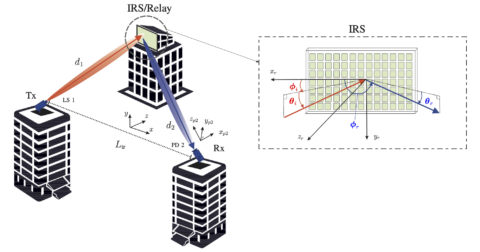Impact of Misalignment Errors on IRS-assisted FSO Links in Different Power Scaling Regimes
Free space optical (FSO) systems, due to their large bandwidth and secure and cost-efficient data transmission, are considered as suitable candidates for next generation wireless communication networks and beyond. The point-to-point FSO channel requires a line-of-sight (LOS) link, which can be relaxed by an optical intelligent reflecting surface (IRS) to connect the transmitter (Tx) to the receiver (Rx). IRSs apply a phase shift profile to redirect, collimate, or focus the beam at the receiver lens. We can characterize the IRS-assisted FSO link using the geometric and misalignment loss (GML). The geometric loss causes the deterministic power reflected by the IRS and collected at the Rx lens to scale quadratically or linearly with the IRS size or to saturate at a constant value. Moreover, since Tx, Rx, and IRS are also affected by random movements due to building sway, a statistical channel model has to be used to account for the impact of building sway.The goal of this thesis is to develop a statistical GML model for IRS-assisted links operating in different power scaling regimes.
Guidelines for the project
- Conduct a literature survey on optical IRS systems
- Study the analytical deterministic channel model
- Develop an analytical statistical channel model
- Simulate the proposed model in Matlab
Prerequisites
- Interest in communications and signal processing
- Basic knowledge of digital and mobile communication systems
- Experience in Matlab
- Basics of μC programming
Contact

